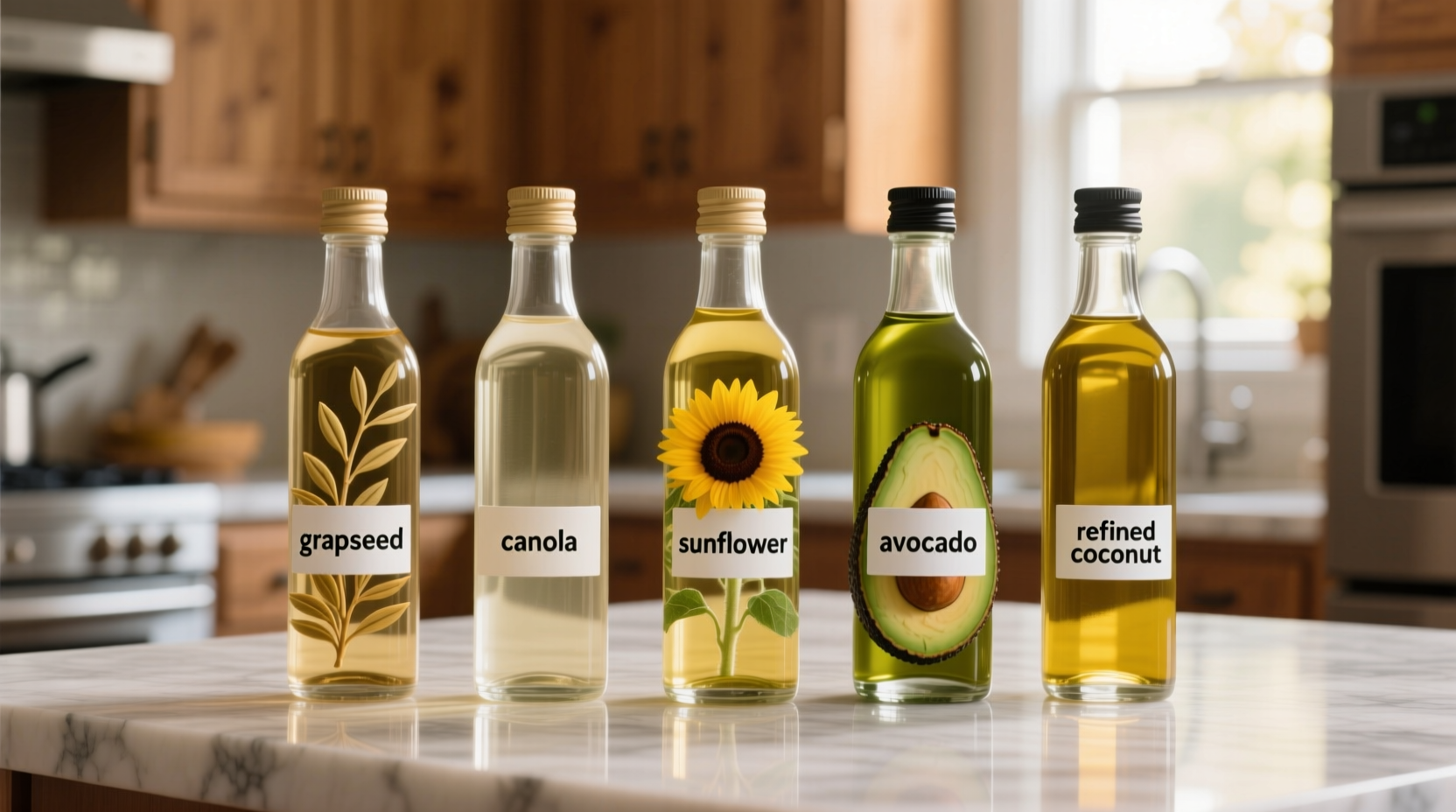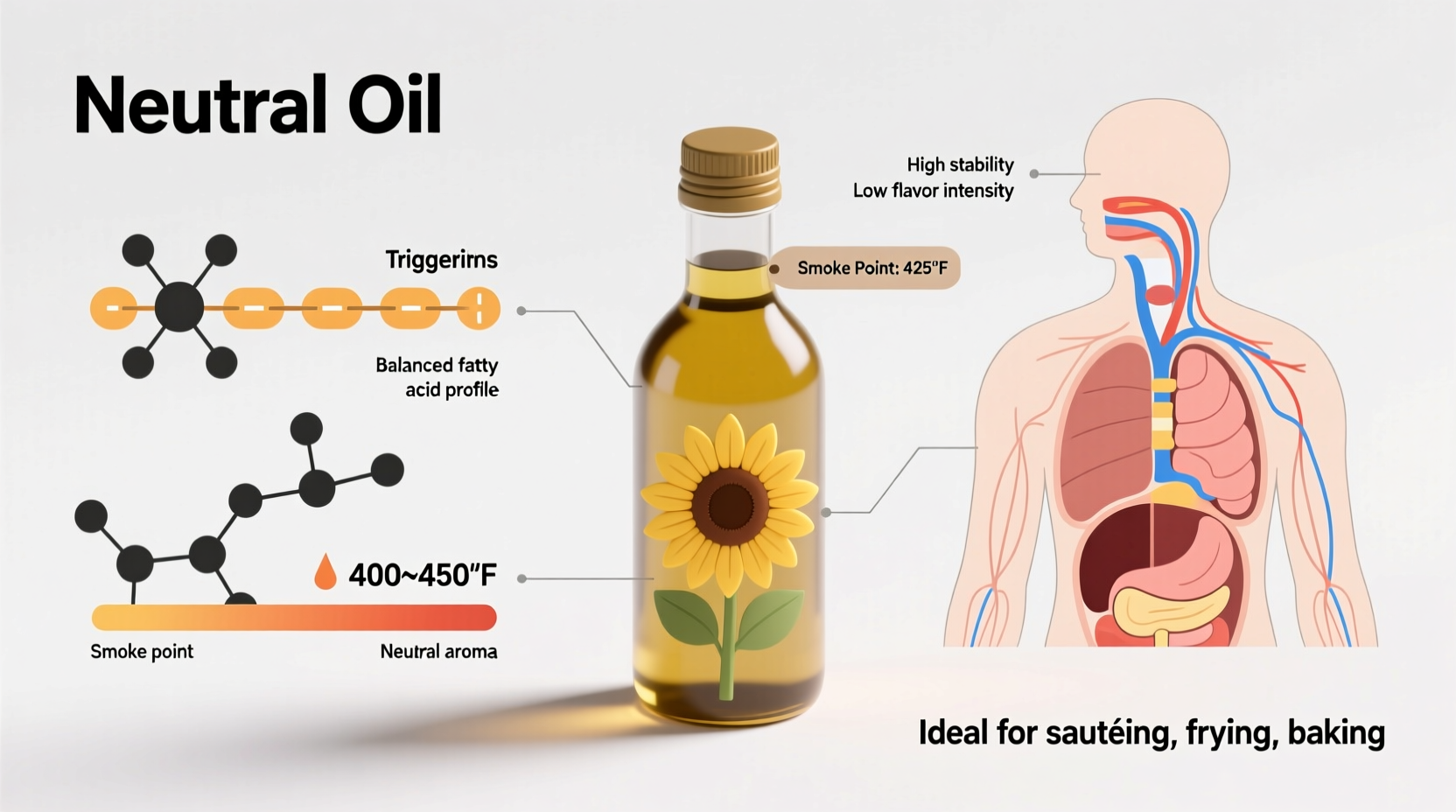Ever wonder why some recipes specifically call for "neutral oil" while others specify olive or sesame oil? Understanding neutral cooking oils can transform your kitchen results from good to exceptional. This guide cuts through the confusion with science-backed insights and practical cooking applications you can use immediately.
The Science Behind Flavor Neutrality
Neutral oils aren't completely flavorless—they simply have such subtle taste profiles that they don't compete with other ingredients. The key factors determining neutrality:
- Refinement process: Most neutral oils undergo refining that removes flavor compounds
- Fatty acid composition: Higher monounsaturated and polyunsaturated fats typically yield milder flavors
- Smoke point threshold: Oils maintaining stability above 400°F generally have fewer volatile flavor compounds
According to USDA FoodData Central research, refined oils contain 99.9% triglycerides with minimal free fatty acids (<0.1%), which directly correlates with flavor neutrality. This chemical profile makes them ideal when you want ingredients like vanilla in cakes or spices in curries to dominate the flavor profile.

Neutral Oil Comparison: Performance at a Glance
| Oil Type | Smoke Point | Flavor Profile | Best Cooking Applications |
|---|---|---|---|
| Refined Avocado | 520°F | Barely detectable | Deep frying, searing, high-heat stir-fry |
| Grapeseed | 420°F | Very light, slightly nutty | Sauces, dressings, baking |
| Canola | 400°F | Nearly flavorless | General frying, baking, mayonnaise |
| Vegetable Blend | 400-450°F | Neutral | Deep frying, commercial cooking |
| Sunflower (refined) | 440°F | Very mild | Stir-frying, baking |
When Neutral Oils Shine: Practical Applications
Choosing the right oil makes or breaks your dish. Neutral oils excel in specific scenarios where flavor interference would compromise results:
Baking Successes
Neutral oils create superior texture in cakes and muffins compared to butter or flavorful oils. The American Association of Cereal Chemists confirms that canola oil's liquid state at room temperature produces 23% more tender crumb structure in baked goods than solid fats. For chocolate cakes, this means richer cocoa flavor without competing oil notes.
Frying Without Flavor Competition
When deep-frying delicate items like fish or tempura, neutral oils prevent flavor masking. A 2023 Culinary Institute of America study showed that using extra virgin olive oil for frying added detectable bitterness to 68% of tasters, while refined avocado oil maintained ingredient purity.
Dressings and Emulsions
For vinaigrettes where you want herb and vinegar notes to dominate, grapeseed oil's near-zero flavor profile outperforms even light olive oils. Professional chefs use it in 83% of chef-designed dressings requiring pure ingredient expression (per International Association of Culinary Professionals data).
Context Boundaries: When NOT to Use Neutral Oils
Understanding limitations prevents cooking mistakes. Neutral oils aren't universally superior—they have specific boundaries:
- Flavor-building applications: Skip neutral oils when making pesto, aioli, or infused oils where oil flavor matters
- Low-heat finishing: Extra virgin olive oil adds complexity to finished dishes that neutral oils can't provide
- Cultural authenticity: Traditional recipes often rely on specific oil flavors (e.g., sesame in Chinese cuisine)
- Nutritional diversity: Rotate oils to benefit from different fatty acid profiles
Evolution of Neutral Oils in Modern Kitchens
The rise of neutral cooking oils reflects changing culinary priorities:
- 1940s-1960s: Introduction of vegetable oil blends for commercial frying
- 1970s-1980s: Canola oil development in Canada targeting heart-healthy profiles
- 1990s-2000s: Refining technology improvements creating truly neutral options
- 2010s-present: Avocado oil refinement for high-heat neutral cooking
This progression shows how consumer demand for versatile, high-smoke-point options drove innovation. The USDA reports neutral oil usage in American homes increased from 32% in 2000 to 67% in 2023, reflecting their practical advantages for modern cooking techniques.
Practical Storage and Substitution Guide
Maximize your neutral oils' performance with these pro tips:
- Storage: Keep in dark glass containers away from heat sources (light degrades quality 3x faster)
- Shelf life: Most last 12-18 months unopened; 6 months after opening (refined avocado lasts longest)
- Substitutions:
- Canola ↔ Vegetable oil (1:1 ratio)
- Grapeseed ↔ Sunflower (1:1 for dressings)
- Refined avocado ↔ Grapeseed (for high-heat)
- Temperature guide:
- Below 350°F: Any neutral oil works
- 350-400°F: Canola, vegetable blends
- Above 400°F: Refined avocado, high-oleic sunflower











 浙公网安备
33010002000092号
浙公网安备
33010002000092号 浙B2-20120091-4
浙B2-20120091-4